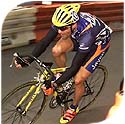|
|
| Be an all-around cyclist | |
Train to bolster your weaknesses to be an all-around better cyclist Many cyclists consider themselves to be great climbers, strong sprinters or powerful time-trialists. However, these types of riders often find it hard to win major races until they redefine their potential abilities and work not only to excel in their specialty but also to simultaneously improve their weaknesses. Here are some suggestions on training your weakness to become a better all-around road cyclist. Time-trialing Time-trialing ability can be greatly improved with practice. If you are looking for large gains in your time trialing, you will have to do time-trial training on a weekly basis while having your body in the actual time-trial racing position. This means either riding your time-trial bike (if you have one) or attaching your clip-on aero bars and making the necessary adjustments to your position on the bike to accommodate the aero position (i.e. seat forward and higher, stem lower). Your time-trial workouts should start with your normally scheduled lactate-threshold workouts (80 percent to 90 percent of your maximum heart rate) or anaerobic-capacity workouts (91 percent to 100 percent of your maximum heart rate) in the time-trial position. When approaching an important 40-kilometer (25-mile) or longer time trial, your workouts should be three to four 12- to 15-minute intervals ridden five to 10 heartbeat per minute above your lactate threshold. Preparing for shorter time trials should incorporate three to four 8- to 10-minute intervals ridden 10 to 15 beats above your lactate threshold. Training time trials once or twice a month are an important part of this program. You should do this training in place of one of your higher-intensity workouts early in the week, or on the Saturday of a non-race weekend. These training time trials should always be taken very seriously and include a full race warm-up and warm-down. Climbing To improve your climbing, do as much of your basic aerobic training (65 percent to 80 percent of your maximum heart rate) as possible in the hills. During aerobic training in the hills, periodically riding at a lower cadence (50 to 60 rpm) will help to develop additional strength. This workout should comprise two to three 15- to 20-minute repeats in the high end of your aerobic training zone (75 percent to 80 percent maximum heart rate) with similar recovery periods. Performing your normally scheduled lactate-threshold and anaerobic-capacity workouts on hilly terrain is a key element in improving your race-speed climbing. When approaching an important climbing event, a variation of standard lactate-threshold training can also be used to bring final improvements. This involves beginning with a standard 20-minute lactate-threshold interval and accelerating into an anaerobic state every five minutes for 45 seconds to 1 minute and then returning back to your lactate-threshold heart rate. This type of race simulation is very demanding, should never be repeated more than three times in a workout and should never be done on consecutive days. Sprinting Sprint training can be broken down into three components: jump, leg speed and duration. The jump portion of your sprint can be improved with work on your level of strength. An excellent workout for this is large-gear standing start repeats. This incorporates doing six to eight standing starts in 53x14 or 53x13 gear combos with a maximum duration of 15 seconds and full recovery between efforts. Doing high-cadence intervals can develop sprinting leg speed. Pedaling in the small chainring at maximum rpm on downhills can do this. Hitting and sustaining cadences of 140 to 180 rpm is the goal. A limiting factor on the duration of your sprint is the amount of fuel your legs have for maximal power output (creatine phosphate). Improving this is accomplished by doing a sprint workout with limited recovery. The efforts should be 10 to 15 seconds in duration and should have only one minute of recovery between sprints. The 18 to 24 sprints should be broken into three sets of six to eight sprints each. Good Luck! |

